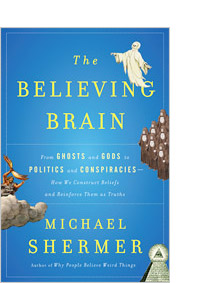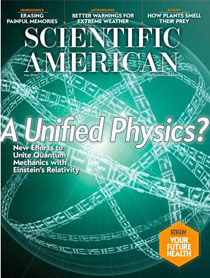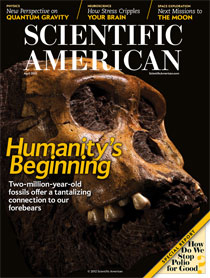Science closes in on why there is something
instead of nothing
WHY IS THERE SOMETHING RATHER THAN NOTHING? This is one of those profound questions that is easy to ask but difficult to answer. For millennia humans simply said, “God did it”: a creator existed before the universe and brought it into existence out of nothing. But this just begs the question of what created God—and if God does not need a creator, logic dictates that neither does the universe. Science deals with natural (not supernatural) causes and, as such, has several ways of exploring where the “something” came from.
Multiple universes. There are many multiverse hypotheses predicted from mathematics and physics that show how our universe may have been born from another universe. For example, our universe may be just one of many bubble universes with varying laws of nature. Those universes with laws similar to ours will produce stars, some of which collapse into black holes and singularities that give birth to new universes—in a manner similar to the singularity that physicists believe gave rise to the big bang.
M-theory. In his and Leonard Mlodinow’s 2010 book, The Grand Design, Stephen Hawking embraces “M-theory” (an extension of string theory that includes 11 dimensions) as “the only candidate for a complete theory of the universe. If it is finite—and this has yet to be proved—it will be a model of a universe that creates itself.” (continue reading…)
read or write comments (14)
My weekend at the New Orleans Baptist Seminary discussing God, religion, and the afterlife
On Friday, April 13, 2012 in the chapel of the New Orleans Baptist Seminary I debated the Liberty University philosopher and theologian Gary Habermas on the question: “Is There Life After Death?” I went first. I stated that since Gary is taking the affirmative I’m suppose to defend the negative, but in fact when it comes to the afterlife, “I’m for it!” Tellingly, that line didn’t get the usual laugh it engenders in audiences, but then in seminary school the afterlife is a deadly serious subject. I began with this thought experiment:
Imagine yourself dead. What picture comes to mind? Your funeral with a casket surrounded by family and friends? Complete darkness and void? In either case you are still conscious and observing the scene.
I then outlined the problem we all have in thinking about life after death: we cannot envision what it is like to be dead any more than we can visualize ourselves before we were born, and yet everyone who ever lived has died so death is inevitable. This leads to either depression or humor. I prefer the latter. For example, Steven Wright: “I intend to live forever—so far, so good.” Or Woody Allen: “It’s not that I’m afraid to die. I just don’t want to be there when it happens.”
Of course, you won’t be there when it happens because to experience anything you must be conscious, and you are not conscious when you are dead. I then outlined four theories of life after death, gleaned from my recent Scientific American column based on Stephen Cave’s marvelous new book, Immortality, which I highly recommend reading. (continue reading…)
Comments Off on Shermer in Seminary School
Recently my friend and colleague in science and skepticism Neil deGrasse Tyson, issued a public statement via BigThink.com in which he stated that he dislikes labels because they carry with them all the baggage that the person thinks they already know about that particular label, and thus he prefers no label at all when it comes to the god question and simply calls himself an agnostic.

The Believing Brain
by Michael Shermer
In this book, I present my theory on how beliefs are born, formed, nourished, reinforced, challenged, changed, and extinguished. Sam Harris calls The Believing Brain “a wonderfully lucid, accessible, and wide-ranging account of the boundary between justified and unjustified belief.” Leonard Mlodinow calls it “a tour de force integrating neuroscience and the social sciences.”
(continue reading…)
Comments Off on Are you an Atheist or Agnostic?
A foreword to Stephen Cave’s Immortality: The Quest to Live Forever and How it Drives Civilization (Crown, 2012, ISBN 978-0307884916), now available in paperback.
On Friday, April 13, 2012 in the chapel of the New Orleans Baptist Seminary I debated a Liberty University philosopher and theologian named Gary Habermas on the question: “Is There Life After Death?” I went first. I began with this thought experiment:
Imagine yourself dead. What picture comes to mind? Your funeral with a casket surrounded by family and friends? Complete darkness and void? In either case you are still conscious and observing the scene.
I then outlined the problem we all have in thinking about life after death: we cannot envision what it is like to be dead any more than we can visualize ourselves before we were born, and yet everyone who ever lived has died so death is inevitable. This leads to either depression or humor. I prefer the latter. For example, Steven Wright: “I intend to live forever—so far, so good.” Or Woody Allen: “It’s not that I’m afraid to die. I just don’t want to be there when it happens.” Of course, you won’t be there when it happens because to experience anything you must be conscious, and you are not conscious when you are dead.
(continue reading…)
Comments Off on A Skeptic Considers Immortality
How awareness of our mortality
may be a major driver of civilization
IMAGINE YOURSELF DEAD. What picture comes to mind? Your funeral with a casket surrounded by family and friends? Complete darkness and void? In either case, you are still conscious and observing the scene. In reality, you can no more envision what it is like to be dead than you can visualize yourself before you were born. Death is cognitively nonexistent, and yet we know it is real because every one of the 100 billion people who lived before us is gone. As Christopher Hitchens told an audience I was in shortly before his death, “I’m dying, but so are all of you.” Reality check.
In his book Immortality: The Quest to Live Forever and How It Drives Civilization (Crown, 2012), British philosopher and Financial Times essayist Stephen Cave calls this the Mortality Paradox. “Death therefore presents itself as both inevitable and impossible,” Cave suggests. We see it all around us, and yet “it involves the end of consciousness, and we cannot consciously simulate what it is like to not be conscious.”
The attempt to resolve the paradox has led to four immortality narratives:
- Staying alive: “Like all living systems, we strive to avoid death. The dream of doing so forever—physically, in this world—is the most basic of immortality narratives.”
- Resurrection: “The belief that, although we must physically die, nonetheless we can physically rise again with the bodies we knew in life.”
- Soul: The “dream of surviving as some kind of spiritual entity.”
- Legacy: “More indirect ways of extending ourselves into the future” such as glory, reputation, historical impact or children.
All four fail to deliver everlasting life. Science is nowhere near reengineering the body to stay alive beyond 120 years. Both religious and scientific forms of resurrecting your body succumb to the Transformation Problem (how could you be reassembled just as you were and yet this time be invulnerable to disease and death?) and the Duplication Problem (how would duplicates be different from twins?). “Even if DigiGod made a perfect copy of you at the end of time,” Case conjectures, “it would be exactly that: a copy, an entirely new person who just happened to have the same memories and beliefs as you.” The soul hypothesis has been slain by neuroscience showing that the mind (consciousness, memory and personality patterns representing “you”) cannot exist without the brain. When the brain dies of injury, stroke, dementia or Alzheimer’s, the mind dies with it. No brain, no mind; no body, no soul.
That leaves the legacy narrative, of which Woody Allen quipped: “I don’t want to achieve immortality through my work; I want to achieve it by not dying.” Nevertheless, Cave argues that legacy is the driving force behind creative works of art, music, literature, science, culture, architecture and other artifacts of civilization. How? Because of something called Terror Management Theory. Awareness of one’s mortality focuses the mind to create and produce to avoid the terror that comes from confronting the mortality paradox that would otherwise, in the words of the theory’s proponents—psychologists Sheldon Solomon, Jeff Greenberg and Tom Pyszczynski—reduce us to “twitching blobs of biological protoplasm completely perfused with anxiety and unable to effectively respond to the demands of their immediate surroundings.”
Maybe, but human behavior is multivariate in causality, and fear of death is only one of many drivers of creativity and productivity. A baser evolutionary driver is sexual selection, in which organisms from bowerbirds to brainy bohemians engage in the creative production of magnificent works with the express purpose of attracting mates—from big blue bowerbird nests to big-brained orchestral music, epic poems, stirring literature and even scientific discoveries. As well argued by evolutionary psychologist Geoffrey Miller in The Mating Mind (Anchor, 2001), those that do so most effectively leave behind more offspring and thus pass on their creative genes to future generations. As Hitchens once told me, mastering the pen and the podium means never having to dine or sleep alone.
Given the improbability of the first three immortality narratives, making a difference in the world in the form of a legacy that changes lives for the better is the highest we can climb up Mount Immortality, but on a clear day you can see forever.
read or write comments (19)





